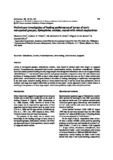Preliminary investigation of feeding performance of larvae of early red-spotted grouper, Epinephelus coioides, reared with mixed zooplankton
- Global styles
- MLA
- Vancouver
- Elsevier - Harvard
- APA
- Help

ดู/
วันที่
1997ผู้เขียน
Page views
3,282ASFA keyword
AGROVOC keyword
Taxonomic term
เมตาดาต้า
แสดงระเบียนรายการเต็ม
Share
นามธรรม
Larvae of red-spotted grouper, Epinephelus coioides, were reared in outdoor tanks with nauplii of copepods (mainly Pseudodiaptomus annandalei and Acartia tsuensis) and/or rotifers, Brachionus rotundiformis. Grouper larvae successfully started feeding on early stage nauplii even though their abundance was as low as approximately 100 individuals l-1 and showed better survival and growth thereafter compared to those fed with rotifers only. Incidence of feeding reached 100% on day 4 when nauplii were available and only on day 9 when rotifers were given alone. Larvae seemed to be poor feeders at the onset of feeding, attempting to capture any food organisms in the tank water. Selective feeding ability of larvae started from day 4 and the larvae then preferred to feed on medium- and large-size nauplii rather than on rotifers as they grew. Larvae appeared to have a better chance at surviving in the presence of early stage nauplii, which were probably caught more easily than rotifers.
การอ้างอิง
Doi, M., Toledo, J. D., Golez, M. S. N., de los Santos, M., & Ohno, A. (1997). Preliminary investigation of feeding performance of larvae of early red-spotted grouper, Epinephelus coioides, reared with mixed zooplankton. Hydrobiologia , 358(1-3), 259-263. https://doi.org/10.1023/A:1003193121532
Type
ArticleISSN
0018-8158คอลเลกชัน
- Journal Articles [1258]
Related items
Showing items related by title, author, creator and subject.
-
Successful use of cryopreserved oyster trocophores as a live first feed larval marine fish and invertebrates
Harvey, Brian J. (Aquaculture Department, Southeast Asian Fisheries Development Center, 1996)Trochophore-stage larvae of the Pacific oyster Crassostrea gigas were cryopreserved in bulk and stored in liquid nitrogen for periods up to two years before thawing and feeding to a variety of warmwater and coldwater larval ... -
Larviculture of marine species in Southeast Asia: current research and industry prospects
Marte, Clarissa L. (Elsevier, 2003)The increased requirement for food fish, the lucrative market for expensive seafood, and the need to conserve marine resources, have motivated the rapid pace of larviculture research in Southeast Asia. Various research and ... -
Diet composition, feed preferences and mouth morphology of early stage silver therapon (Leiopotherapon plumbeus, Kner 1864) larvae reared in outdoor tanks
This study examined the diet composition, feeding preferences, and mouth morphology of the silver therapon (Leiopotherapon plumbeus, Kner 1864) larvae under captive conditions. Larvae were reared in outdoor tanks (4 ...






